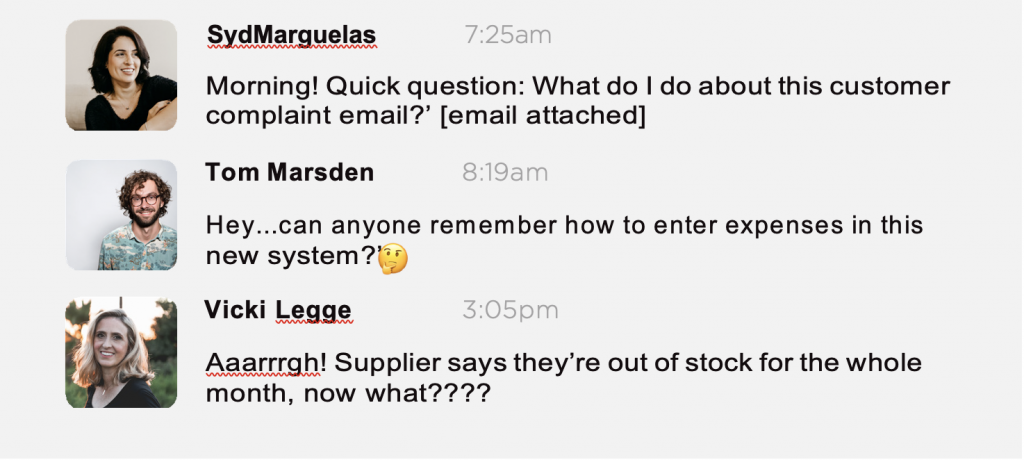Have you looked into your Slack channels (or your organisation’s social learning platform or instance chat messaging system) lately?
It’s a place where colleagues communicate, collaborate and drive projects, doing deep work. Or it can look more like this:

If you are thinking, ‘Well, that’s a friendly, busy, collegial team of people helping each other’, I’d like you to think again.
PRODUCTIVITY KILLERS
The problem with work interruptions, as confirmed by empirical studies, is that ‘people in the interrupted conditions experience a higher workload, more stress, higher frustration, more time pressure and effort’. Further, it takes an average of 23 minutes and 15 seconds to get back to the task after being interrupted.
Given those findings, it is not difficult to imagine the overall impact on productivity when people cannot find the information they need when and where THEY need it. For me, that’s the bottom line of human-centred learning design. If you cannot provide the learning or information when, where and how individuals require it, you’re missing the human in your design.
DIMENSIONS OF HUMAN-CENTRED DESIGN
Here is what humans need when it comes to learning that allows them to perform well:
Learning in the right TIME
Do you have any thoughts about the people you recruited and who have already started in their roles, but still have to wait a couple of months to get started in formal induction training? Who and what will inform their honeymoon time in your organisation, and how will you harness their first impressions to benefit from their ‘fresh pair of eyes’? If you are ignoring the right time for the availability of learning, both employers and employees are missing out. Chances are, your new recruits can be found in the Slack channels, hunting for information.
Learning in the right CONTEXT
Imagine you had to train your army for close combat situations in arid, rural regions; however, all your training videos and materials show close combat scenarios in jungle surrounds. Despite the ‘close combat’ angle remaining the same, one can argue that all other aspects will render jungle training useless to prepare for any other scenario. Quick self-check: are you still using training videos in which people shake hands? We are still in an active pandemic.
Learning in the right PLACE
We need to move away from understanding ‘learning’ as something that only happens whenever L&D offers training sessions, whether online in an LMS or face-to-face in training rooms – or even a total hybrid approach. People should be able to learn instantly, whether they are sitting at a desk or carrying a handheld POS device on a shop floor.
You can do it!
‘But I can’t keep re-designing my training courses every five minutes whenever something changes! I don’t have enough staff!’ My answer to that is, ‘Yes, with smart use of technology and the help of user-generated content, you can!’
Here is how to do it using a social media approach to learning platforms and campaigns:
Start by listening.
I mean, really listening. Find out what people think or believe are the biggest barriers to them performing well in their role. Run polls and surveys and plan learning content around what people say they need; not what managers think or believe they may need. And yes, read those Slack threads.
Next, ask questions.
Look at search stats. What are people searching for most often? Look at learning stats. Which video gets watched most often? By whom? Are they rewinding a certain passage and rewatching it? Why?
Then, map out solutions.
Engage your subject matter experts in the production of artefacts to use in a learning content. Consider where else you can place learning so it’s in the moment of need. There may be opportunities to show role-based, pop-up system prompts within infrequently performed tasks. In the case of eLearning, use authoring tools that allow you to push out learning to mobile devices and enable xAPI statements so you can get valuable data to pivot quickly as needed. You could always have a Slack bot programmed with answers to FAQs too.
Gone is the time of happy sheet post-evaluations and hopefully ‘making the training better next year, for the next cohort’. This outdated approach of long-winded planning and rolling out approaches to training deployment only leads to slackness all round (pardon the pun!). It will not keep organisations competitive and fit for today’s fast-paced era of constant change. It’s time to broaden our horizons.
This article by Melany Blackwell originally appeared in Training & Development magazine, September 2022 Vol. 49 No. 3, published by the Australian Institute of Training and Development.

Recent Comments